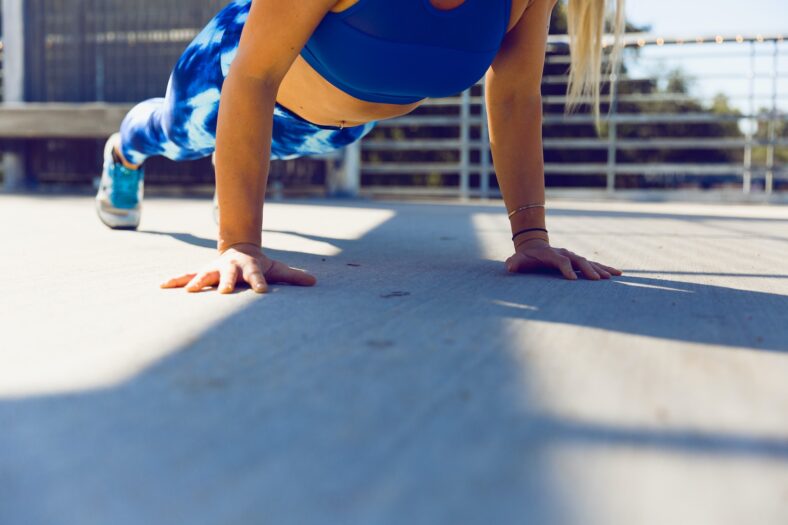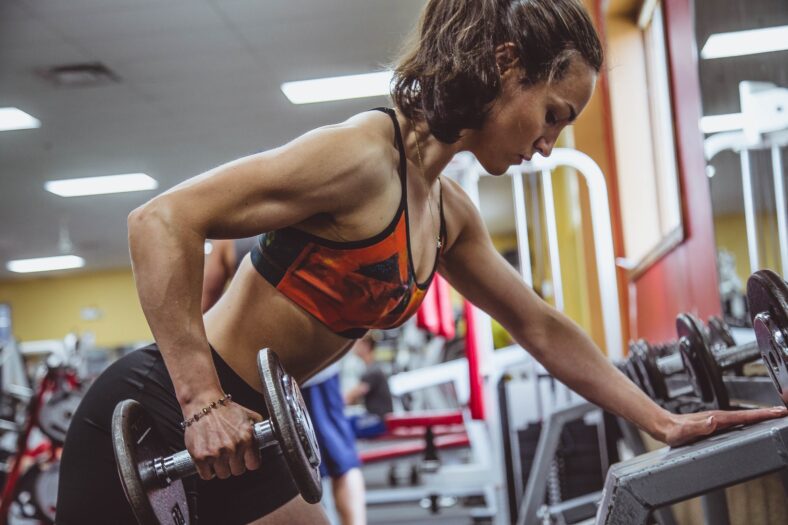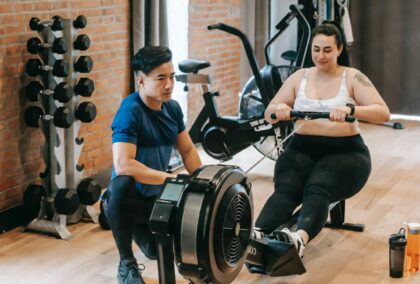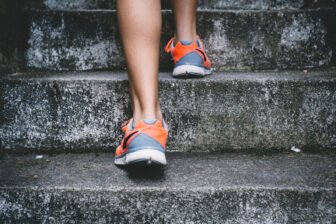Working out on the rowing machine is a great way to have a full-body workout without too much strain. Rowing actually works out 86 percent of the body’s major muscle groups, keeping us healthy and strong. But what about the other 14 percent? In this article, check out what muscles does rowing not work, and twelve exercises to get the last 14 percent of your body in shape.
RELATED: 8 Things to Know About Rowing Machine Exercises
What Muscles Does Rowing Work?
Rowing works on your upper and lower body as you pull and shoot forward on the machine. In terms of your lower half, rowing works your hamstrings, glutes, calves, spinal erectors, and quads. On your upper half, the forearms, biceps, and lats get a great workout as you pull the rope towards you.
What Muscles Does Rowing Not Work?
There are four main groups of muscles that rowing does not work. They are the chest, top shoulder muscles, hip abductors, and abductors. Though they may be slightly used during the workout, the machine does not completely activate the muscles.
These muscle groups are important though, as our shoulders are one of the most moveable joints and the chest helps with lifting heavier objects. In terms of the hips and abductors, you need those for flexibility and stability while walking or doing more intensive exercises.
Though they are not the major muscle groups everybody thinks of, they are still important to keep in shape.
12 Exercises to Target the Chest, Shoulder, and Abductor Muscles
Since rowing does not do it all for your muscles, check out these targeted exercises to keep your whole body in shape.
Chest Exercises

12. Pushups
There are various types of pushups you can do – regular, incline, decline, and plyometric. Of course, you can also vary the distance of your arms with diamond or wide pushups, creating a varied experience each time you decide to work out your chest.
The best way to do this exercise is to lay on your stomach and push your arms up directly in line with your shoulders. Then press down with your arms, and once your arms are bent then slowly come back up.
11. Chest Press
Similar to the pushups, there are regular, incline, and decline chest presses. This exercise requires dumbbells. Lie on your back with your dumbbells in your hand at shoulder height, making sure your arms are about 45 degrees from the body. Push the weights upward while exhaling, making sure to go slow and should almost meet at the top of the chest. Then, slowly lower back down to the starting position and repeat.
10. Chest Fly
Lie on your back, preferably on a flat bench. Place your feet firmly on the floor on either side of the bench. Gently grab the dumbbells from the floor and hold one in each hand. Lift your arms above your head, extended but not locked, and have your palms facing each other. Inhale and lower the dumbbells until they are in line with your chest, making sure not to go lower than your shoulders. Then on the exhale slowly press the dumbbells upwards to the starting position. Repeat this motion.
Top Shoulder Muscles

9. Dumbbell Lateral Raise
Stand with your feet around shoulder width apart, dumbbells in your hands with a slight bend in your arms. Slowly raise the dumbbells to each side, making sure that only your arms are moving during the exercise. Stop when you are at shoulder level and slowly lower the weights back to the starting position, and repeat the motion.
CHECK OUT: Workout Guide to Wall Pilates for Seniors
8. Front Deltoid Raise
Start with your feet shoulder width apart and have the dumbbells in front of your thighs, with the backs of your hands facing away from you. Raise the dumbbells up while bending your elbows until they are level with your shoulders. Then, rotate your hands slightly so the inner sides of the dumbbells point upwards and lower them into starting position.
7. Dumbbell Bent-Over Raise
For this exercise you will want to have your torso bent until your chest is nearly parallel to the floor. With dumbbells in both hands, raise your arms out to the side as you lift the dumbbells until they are parallel to the floor. Lower back to the starting position and repeat.
Hip Abductors
6. Sumo Squat
In a traditional squat stance, clasp your hands together on your chest. Spread your feet three to four feet wide and angle your toes outwards. Slowly bend down into a squat position, keeping your back straight and your thighs parallel to the floor. Pause in this position to feel the stretch in your legs and then press back up into a standing position.
5. Bicycle Crunch
Lie on your back with your legs tucked upwards. Place your arms underneath your head with elbows bent, lifting slightly and engaging your core. Next, pull your left knee towards your right elbow, twisting your body as you do so. Return to starting position and repeat with the opposite knee to elbow motion.
4. Standing Hip Abduction
Start standing straight up with your feet facing forward. Move your right leg out to the right until you feel strain on the outside of the hip. Bring your leg back down to standing position and then do the same to your left leg. Use a resistance band to increase the difficulty.
Abductors

3. Clamshells
This exercise can be completed with or without a resistance band. Start by lying on your left side, legs together and knees bent. With feet staying together, slowly raise your right knee opening up like a clam shell. Hold this position for five seconds before returning to the starting position. Once you complete your left side sets, switch over to your right side.
2. Lateral Lunges
Start in a standing position with your feet hip-width apart. Take a big step to the side with your right leg, bending your right knee as you feel the pull in your inner left thigh. Lower until your knee is bent to ninety degrees, and then slowly push back to the start. Either alternate with each leg or do one set per leg.
1. Lateral Leg Lifts
Lay down on your right side and make sure your hips are perpendicular to the floor. Tuck one arm under your head, either bent or straight, and place the other over your side and onto the ground. Slowly lift your left leg into the air, making sure it stays even with the rest of your body. Once you feel the pull of the abductor then lower your leg back to the starting position. Repeat this on this side several times before moving to the other side.
ALSO READ: Yoga Ball Bouncing: What Are the Benefits of This Exercise?
Working out is a great way to keep your body in shape and lessen joint pains. Rowing is especially great because it is a low impact exercise that will not aggravate any tender muscles. But, always make sure that you are working out those muscles that do not get used with the rowing machine – chest, top shoulders, hip abductors, and abductors. With a couple of these extra exercises, you can have a full body workout that isn’t too taxing on the body, and you’ll feel great at the end of every set.


